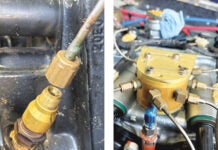New home, new airport—they present an opportunity to learn. This learning has been especially acute since the beginning of the year and my move to Oregon. The joke about the PacNW being gray and soggy during the winter isn’t just hyperbole generated by Oregonians and Washingtonians trying to keep Californians south of the border. There’s something to it, after all.
As a former Californian, I’m starting, finally, to get in tune with the area’s micro climates. The weather at my airport, Twin Oaks, may or may not be anything like the two nearest reporting points: Hillsboro to the north and Aurora to the southeast. I’d grown accustomed to widespread similar conditions and great predictability, both in California and, to a lesser extent, in Rhode Island. Here in Oregon, the winter was full of massive variability and blown forecasts. Never have I seen so many updated terminal forecasts in my flying career. (Or maybe easy access to online weather makes it seem more common. Hard to say.)

In a way, I’m grateful that the GlaStar is still in VFR-only land because that makes the weather decision-making a lot easier. If it’s truly crummy, I’m not going. Meanwhile, I’m learning to interpret how the weather flows along the surrounding terrain and what kinds of motion the systems depart on them. But sitting it out is not going to be viable when my work season gets truly underway in spring and I expect to get places in a single-engine Experimental.
Which, mercifully, brings me to the point: How much capability do I need to retrofit into the airplane? I look back on my time with the Sportsman, which, early on, got by just fine with a single nav/com and a VFR GPS, albeit one with XM weather. I don’t recall any flights where I couldn’t get to where I was intending that an IFR GPS would have made possible.
In time, I added a Garmin GNS 430W, almost as much so I could test a number of new display and autopilot technologies as to satisfy a demonstrated need. It caused the attached autopilot to fly the airplane beautifully and was generally a better way to navigate, but I don’t think it got me to places I couldn’t reach otherwise. Which may say more about my choice of destinations and weather conservatism than anything bolted to the panel.
Now the plan is to go with an IFR GPS as the primary navigation tool, and I have heard the arguments about platform flexibility. The issue is more one of what happens when/if the GPS signal is blocked or otherwise unavailable. In this case, there’s no VHF to fall back on, and it’s likely that my key backup—a combination of the Garmin GDL 50 and an iPad, which gives me redundant, battery-powered AHRS/GPS and display completely independent of the aircraft electrical system—will be similarly affected.
Is this approach—with the kind of redundancy, or lack of it—good enough? I would agree it’s not robust enough for an all-weather airplane, something that also has lots of power, de-icing equipment, onboard weather radar and all the other features you get when the engine up front says Pratt & Whitney on the label. But let’s be honest: The GlaStar is not that kind of all-weather airplane.
Build to Maintain
I admit that one feature built into my GlaStar didn’t really turn me on when I heard about it, seeming more like a “nice to have” than a game changer. Specifically, the builder of this airplane, Charlie Eubanks, created a semi-permanent center stack flanked by panels that hinge downward on the steel tube that crosses the fuselage just behind the panel. In fact, during the early projects, I didn’t even use it, mainly because I was working on the pilot’s side and dropping the panel means disconnecting each instrument attached to it. I found it easier to work over the top and up from the bottom.

Different story on the right. My current project is a wholesale replacement of the analog engine instruments. (More on that next month as we look at engine monitors in detail.) What a treat to sit there, in the passenger seat, and work behind the panel. What a treat not to be lying under the panel, working through a narrow slot. I’m more flexible than I used to be, but still…
Point is: If as you’re building, consider maintenance accessibility as part of the prime directive, not as a “nice to have.” I can only speak for myself, but I tend to do neater, more thoughtful work when I’m physically comfortable. And I tend to make fewer mistakes, which ultimately saves a lot of time and heartache. I know it’s tempting to think you’ll only do this once, but as we’ve discovered in our Buying Used series (which returns next month, looking at the Kitfox models) homebuilts get modded and updated all the time.
As I work through the inevitable, protracted, probably unnecessary upgrade process on this circa-2002 airplane, I’m sure Charlie’s efforts will cause me to smile and offer silent thanks. You could do the same for the future owner or owners of your pride and joy.














I worked on a DC-3 one time and we cursed the instrument installation on it because the wiring harnesses were about 3 inches too short and we hade to get on a stand to lift the front hood cover to unscrew the cannon plugs on otherwise front removable instruments. Be kind to your self and make provisions for future maintenance activities.